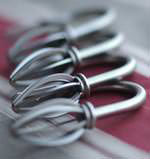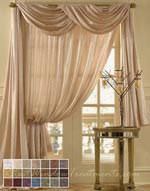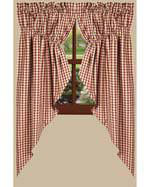|
Window Treatments
home > Site Information Center > Benefits
of Window Treatments
Window Treatments - Where to Start
Click
here to see the Benefits of Window Treatments.

 Here's some help if you are just getting started:
the first question you may ask is whether you want hard or soft window treatments or a combination of both. Here's some help if you are just getting started:
the first question you may ask is whether you want hard or soft window treatments or a combination of both.
A hard "window treatment" is, as the name implies, made of "hard materials", such as wood or vinyl. Some examples are shutters, blinds and possibly shades. If you decide to go with plantation shutters, for example, (although they can be costly) you can have your window covering done in one simple step. If you decide to start with blinds or shades you may need to add a soft window treatment to for a finished look.
A soft "window treatment" is made from softer materials such as linen, polyester, silk and everything in-between. Some examples include sheers, curtains, drapes, panels, swags, valances, cornices, and soft shades (such as Roman Shades made out of fabric). This is where you can really add dramatic design elements to your home, that may completely transform an entire room. Feel free to browse around our store to see examples of terms that may be unfamiliar to you. This will also let you identify a match for your own taste and home decor.
Hardware is used to mount your window covering and can consist of curtain rods, rings to hold the curtain, and brackets to connect to the ceiling or wall. Safety is the most important consideration with hardware. You want to make sure it is going to properly support your desired coverings. Your hardware may be included with your treatment, while others will allow you to pick out your own curtain rod and decorative accents.
Decorative accents. While overlooked at first, a second look will tell you that decorative accents can make a normal treatment look completely finished with panache. Often the eye will be drawn to the "extra finishes" instead of the main focus. For decorative (and often functional accents) we have holdbacks, finials, tiebacks, scarf holders, tassels, rosettes, and swag holders.
Remember - Your own unique style is the most important element for a window treatment! Next you may consider desired light filtering and insulation properties (which can help with the electric bill!) Insulation can be easily achieved by adding design layers to your window or glass door. Design layers usually begin with blinds or shades followed by curtain panels or drapes and may include a top treatment (such as a cornice or valance.) (Sometimes called a "window topper".)
For a more casual look try a soft Roman Shade topped with a scarf valance. Perhaps you have a "problem window"? It looks a bit too small or sits too close to the ground or is mix-matched with the rest of the room. Curtain panels are the perfect home decor solution for creating a different "space". Just place the curtain rod 2 inches below the ceiling on the wall and let your panels softly touch the floor. This will create the illusion that it is higher off the ground and larger, because the eye is drawn to the dramatic hanging curtain panels - not the "problem window". As you can see, you are actually incorporating home decor elements that affect the appearance of the entire room.
|



















